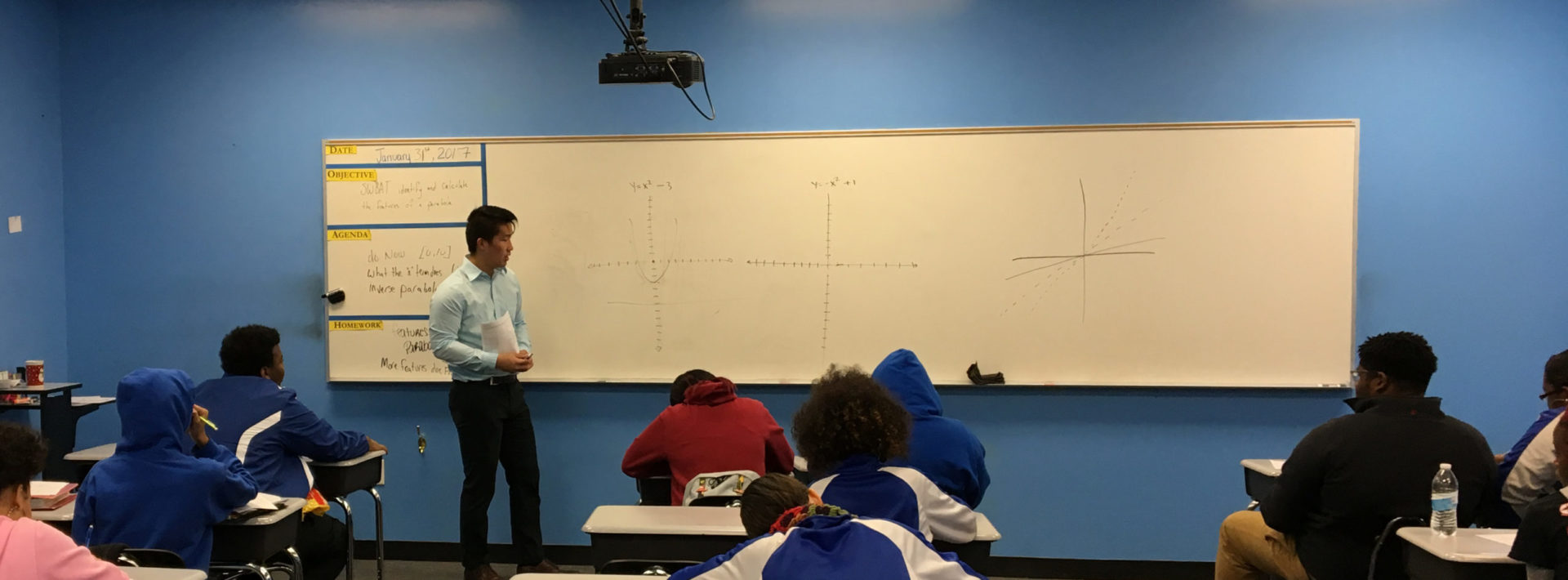IAP 2017: Four Weeks for America

By David Wu ’19
My sister always jokes that I peaked in high school, so I guess I’m spending my IAP trying to re-live the glory days. This IAP, I have been working as an assistant to a Teach For America (TFA) teacher named Seamus at KIPP Gaston Pride (GP) High School in Gaston, North Carolina. Seamus is a second-year Teach For America participant who graduated from Cornell with a degree in Economics. He currently teaches Pre-Calculus to 11th and 12th graders at KIPP GP.
Gaston is part of Northampton County, one of the poorest counties in North Carolina. There is also a lack of STEM exposure and skills provided to the students. Through “Four Weeks for America,” a joint program between the MIT PKG Center and Teach For America, I and other MIT students have tried to present STEM areas and possible careers to Gaston students, as well as develop math and problem-solving skills during this four week period.
KIPP GP has a student body of about 350, made up 83% black, 10% white, and 7% Latino/Other. KIPP GP perform in the 54th and 51st percentiles in the state for reading and math, respectively. This maybe a result of the longer school day that goes from 8 am – 5 pm Monday through Thursday and 8am – 2pm on Fridays. While these students outperform their peers from the Halifax County high schools, I believe there is still a large gap between their skill level and what is required for mastery of a subject. It is my goal to find ways to help close this gap.
In the classroom, I assist students working on assignments. I meet regularly with students who need individual help during lunch, study hall, and after school. This has been a great time to not only get to know the students personally, but also reinforce fundamental concepts and identify holes in their knowledge.
Two students that I have spent a considerable amount of time with, Mike and Tyrell, are big basketball and football fans, so we have been able to bond over our shared interests. Mike is a very hardworking senior, but lacks the solid foundation of basic algebra and arithmetic skills. While he has a grasp on the topics covered in class, often times his lack of algebra proficiency causes confusion. In order to best help him, I create flow charts to visualize the type of problem solving thinking that will help him think clearly. With his work ethic, I am sure that Mike will always be able to improve his skills.
Conversely, Tyrell is a gifted athlete and student who is interested in sports medicine. However, Tyrell is not challenged by his classes and doesn’t want to do his work. Therefore, usually he either skips class or distracts other students in class. My goal with Tyrell is to find ways to intellectually stimulate him with videos combining physics and math with sports in order for him to change his perception of these subjects. Ultimately, I would like him to realize that the learning in the classroom can help him better understand the world around him and solve problems that do not have a simple answer.
Another student who I have tried to expose to the breadth of possibilities in the STEM fields is a quiet kid named David. He is a gifted student who is interested in computer science and is planning on applying to MIT. I have showed him some the cool things I have been able to do in just 1.5 semesters at MIT such as doing fieldwork at ancient sites in Italy (1.S993) and designing and 3D printing a parameterized model of a beaver dam (1.101) and he has reacted very positively. He took AP Computer Science last year, but unfortunately the teacher left and the school no longer offers the course. As a result of the low pay (NC ranks in the bottom 10 of average teacher pay) and taxing work, teacher retention and quality teacher retention is very low. Therefore, students like David that would love exploring areas that spark their curiosity and challenge them are left in classes that are too easy for them and unable to reach their full potential.
As I have spent more time with the students, I have gotten to see their improvement even in just a handful of days. For example, the first time I worked with a girl named Kira on exponent concepts she would use phrases like “I quit!” and “I hate this” at the first sign of struggle. Struggle is guaranteed as an MIT student, but it is the process of working through this struggle that the best learning and confidence growth occurs.
With Kira, I try to ask her questions that force her to think about the problem in a different manner. I hope this sideways thinking will help her realize that her math knowledge is cumulative and interconnected rather than disjoint islands of formulas. After working with Kira for a few days, the most noticeable change in Kira is her attitude. It seems that she feels more comfortable struggling with a question before asking for help, and hopefully she can continue to develop her analytical skills.
On a final note of reflection after these two weeks, I think about what it takes to be a motivator and a champion for these underserved students. My work so far has definitely not been easy, but I didn’t expect it to be. I appreciate the amount of effort that teachers put in every year day in and day out to create engaging material, design curriculum, speed up kids who are behind, and also inspire their high achieving students.
Teachers are some of the most underappreciated members of our society and their work usually goes unnoticed by everyone except their students. In fact, on the day prior to the quarter final exam Seamus and I worked with students until after 9pm providing extra help and allowing students to redo assignments that they score poorly on. After spending over 12 hours at school, Seamus then baked cookies for all five of his classes until 2am.
I’d like to acknowledge and applaud the hard work and dedication from Seamus and teachers all around the country that go the extra mile every day to develop their students’ skills. This is what helps students build character, confidence, and skills. Better teachers mold better students.[/fusion_text]
Share on Bluesky

